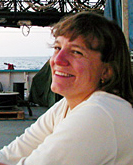Well, it finally happened. The unusually fine weather we had for nearly three weeks came to an end last night as a moderately strong low pressure system swept by us. The winds picked up, as did the seas, and the shampoo bottle — my highly sophisticated barometer -tumbled over as the Knorr pitched and rolled about. I had previously been marveling at its stability for so many days, but this is the North Atlantic after all, and this cruise would not have been complete without some kind of stormy weather. All in all it wasn’t too bad — the highest wind speed I saw was about 38 knots (similar to miles per hour) and the seas were maybe 10-15 feet. I took some Dramamine last night before going to bed in anticipation of the coming storm–I’m not sure which makes me feel worse, the ship’s motion or the medication! As the seas rose, I had a hard time sleeping, but overall didn’t feel too badly.
Fortunately for all the scientists on board, today was mostly a day off from the normal CTD routine as we have been steaming toward our final study site, the Bight Fracture Zone.This is the one time in this cruise where we might discover something new right away, without having to wait to recover our moorings or for floats to surface in two year’s time.
The bight Fracture Zone is a deep crack in the submarine mountain range called the Reykjanes Ridge. As described in earlier posts, this mountain chain stretches southward from Iceland all the way into the South Atlantic and beyond. It separates the Atlantic Ocean into eastern and western basins. Any water that is deeper than the crest of the ridge is trapped on one side or the other. but in just a few locations, there is a crack in the ridge — more like a mountain pass . — where deep waters can flow from one Atlantic basin to the other.
The largest and most well-known of these is the Charlie-Gibbs Fracture Zone well to our south. A less studied break is this Bight Fracture Zone. Years ago I released some subsurface floats in the eastern Atlantic, and they escaped to the western basin through this pass. And there is a computer model that predicts a large flow from the eastern to the western basin through this crack. But surprisingly, we think we are the first to visit it and make a high-resolution cross-section of the currents and water properties in the pass. We may see for the first time a funneling of the flow through this gap and be able to estimate its magnitude. It’s sort of like a drain or culvert–as it gets narrower, the speed of the water flowing through increases. As I write this, the CTD is being lowered into the deepest part of the gap, which is where we expect to see the strongest currents. I should be heading off to my bunk now, but I just want to stay up a bit longer and see the results from this cast. This is some of the most exciting work we will do on this cruise, and I don’t want to miss any of it!

 Amy Bower is a physical oceanographer at the Woods Hole Oceanographic Institution. She has been chasing ocean currents in the Atlantic and Indian Oceans for over 25 years, primarily by releasing acoustically tracked floats far below the sea surface. Legally blind since her mid-20s, Amy uses adaptive technology to continue her research.
Amy Bower is a physical oceanographer at the Woods Hole Oceanographic Institution. She has been chasing ocean currents in the Atlantic and Indian Oceans for over 25 years, primarily by releasing acoustically tracked floats far below the sea surface. Legally blind since her mid-20s, Amy uses adaptive technology to continue her research.